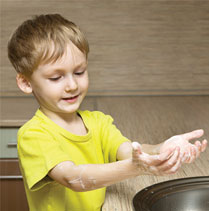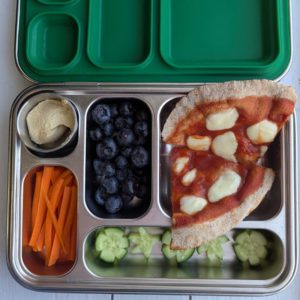
Here are simple food safety practices that you can add into your family’s daily routine.
These good habits will serve your kids for a lifetime. Neglecting them may lead to serious health consequences, but do not panic—here is a basic list to get you started.
Hand Washing
It is true that hand washing is the simplest and most overlooked way to avoid spreading germs. Be sure to wash your hands with your kids before you eat or cook, after touching raw foods like meat and eggs, and after sneezing, coughing or using the restroom. Most people do not do it enough – or properly. Here’s a quick refresher:
- Wet hands with the hottest water you or your child can stand.
- Apply soap
- Rub hands and fingers together for at least 20 seconds. To properly cleanse hands, the process should last 20-30 seconds or the time it takes to sing Happy Birthday twice, say the alphabet in your head, or recite a nursery rhyme 2-3 times.
- Rinse thoroughly
- Dry hands on a designated hand towel (and wash the towel often) or use disposable paper towels.
Cross-Contamination
Germs can very easily spread around your kitchen and contaminate everything! Bacteria can be transferred from one place to another from contaminated cutting boards and countertops, wreaking invisible havoc! It’s best to think of every food as risky and act accordingly:
Store and defrost raw meats and poultry on the bottom of your fridge away from ready-to-eat foods like fruits and veggies. Keep raw meats and poultry covered to prevent juices from dripping onto other foods.
- Don’t rinse meat before preparing – this may spread bacteria onto your sink and other surfaces.
- Prepare raw and cooked foods separately. Have two separate cutting boards, one for raw meats and one for fresh produce. Never, use the same knife or cutting board to slice raw meat and to chop vegetables!
Temperatures for Cooking and Reheating
How do you know whether food-borne illness is lurking on your plate? Since potentially food-poisoning bacteria are invisible, you don’t! Therefore, always cooking foods to the right temperatures helps to make food safe. Eliminate the guesswork and pick up an instant-read thermometer. They are cheap and easy to use.
Here’s how to get started: Insert the thermometer into the thickest part of the food. For a proper reading, insert the bottom 2-inches of the thermometer probe (called the sensing area). For flat foods like burgers, insert on an angle.
|
Cooking Temperatures of Common Foods |
|
| Poultry—whole or ground (turkey, chicken, duck, goose) |
165°F for 15 seconds. |
| Leftovers and casseroles |
165°F for 15 seconds. |
| Fresh beef, veal or lamb |
|
| Ground meats (pork, beef, veal, lamb) |
160°F for 15 seconds |
| Ham |
|
| Eggs |
|
For more cooking temperatures, check out USDA’s Thermometer Fact Sheet
High-risk Foods for Children
Children under 6 do not have the disease-fighting capacity of older kids and adults. Here’s a list of foods that are potentially high risk and some tips on making them safe.
Raw eggs: Do not taste batter containing raw eggs. Make sure all eggs served are pasteurized or thoroughly cooked before serving.
Unpasteurized (raw) milk & cheese: These foods may contain harmful bacteria and viruses and should be avoided.
Fresh juices sold in stores: Look for the label indicating it is pasteurized.
Raw Sprouts: Avoid raw sprouts whenever possible. They’ve been known to carry many harmful bacteria.
Hot Dogs: Make sure to cook thoroughly to 160°F.
Melons: The outside of the melon carries dirt and bacteria which transfers into the center when slicing. Be sure to wash well before cutting.
For more information and tips check out: https://www.fightbac.org
Test Your Knowledge:
Foods that carry a high-risk of foodborne illness for children include:
a. Broccoli
b. Hot Dogs
c. Bananas
Answer: b. Hot Dogs. Always cook thoroughly to 160°F.
The safest way to defrost frozen meats is to:
a. Place them in a container and leave on the counter or in the sink
b. Place them in warm water in the sink
c. Place them in the bottom of the fridge overnight
Answer: c. Place them in the bottom of the fridge overnight.












